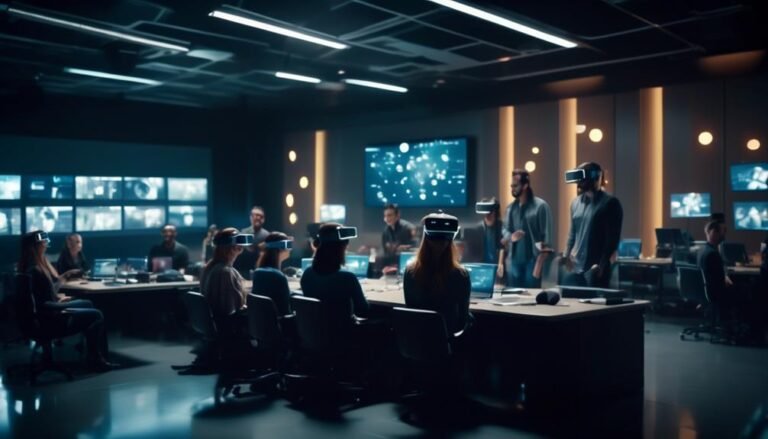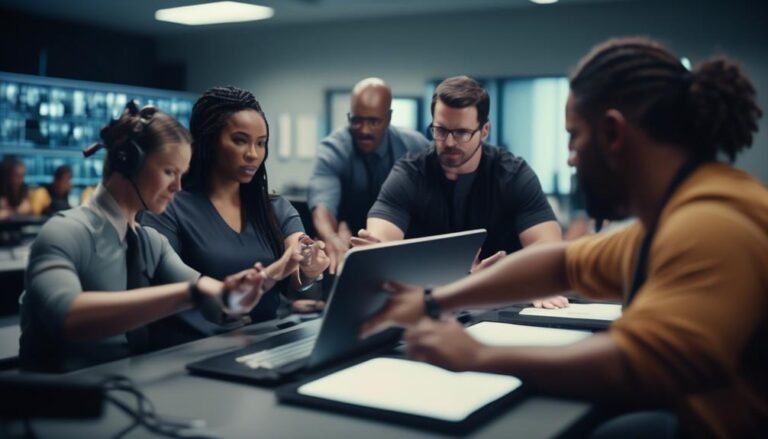Advanced Skills Training: Preparing Employees for Tomorrow's Challenges
In today's rapidly evolving business landscape, the need for advanced skills training has never been more critical. As organizations navigate through technological disruptions, changing market dynamics, and global uncertainties, the demand for a highly skilled and adaptable workforce has soared.
The question is, how can companies equip their employees with the necessary expertise to thrive in tomorrow's challenges? This discussion will explore the essential strategies and considerations for preparing employees to not just survive, but to thrive in the face of the dynamic and complex challenges that lie ahead.
Key Takeaways
- Workplace adaptation is essential for keeping up with the evolving landscape of technology, automation, and globalization.
- Anticipating industry shifts and assessing future skills needs is crucial for staying ahead and ensuring workforce readiness.
- Designing tailored training programs based on industry foresight and skills mapping helps equip employees with the necessary expertise.
- Leveraging technology for learning, such as interactive platforms, mobile apps, AI, and gamification, enhances engagement and maximizes learning outcomes.
The Evolution of Workplace Demands
As the global economy continues to evolve, so do the demands placed on the modern workplace. Workplace adaptation has become a necessity as businesses strive to keep pace with the rapidly changing landscape. This has led to a significant evolution in the skills required of employees to ensure they remain effective and competitive.
The modern workplace demands a high level of skill evolution as technology, automation, and globalization continue to reshape industries. Employees are expected to adapt to new tools, software, and processes, requiring a continuous commitment to learning and upskilling. Additionally, the rise of remote work and virtual collaboration has created a need for digital literacy and proficiency in online communication platforms.
Furthermore, the demand for soft skills such as adaptability, problem-solving, and emotional intelligence has grown, reflecting the importance of interpersonal abilities in an ever-changing work environment. Employers now seek individuals who can navigate uncertainty with resilience and lead teams through complex challenges.
Identifying Future Skills Needs
As industries continue to evolve at a rapid pace, it becomes crucial for organizations to assess the future skills needs of their workforce.
Anticipating industry shifts and identifying the skills that will be in demand is essential for staying ahead in the competitive business landscape.
A proactive approach to future skills assessment can ensure that employees are equipped with the capabilities required to meet the evolving demands of the market.
Future Skills Assessment
The identification of future skills needs is a critical component of effective workforce planning and development. Skills forecasting, performance evaluation, predictive analysis, and skills gap assessment are essential elements in determining the skills that will be required in the future.
Through skills forecasting and predictive analysis, organizations can anticipate the specific skills that will be in high demand. Performance evaluation helps in identifying the existing skill sets within the workforce and assessing their alignment with future needs.
Additionally, skills gap assessment enables organizations to understand the variance between the skills employees currently possess and the skills that will be needed in the future. By conducting a comprehensive assessment of future skills needs, organizations can proactively prepare their workforce to meet the upcoming challenges and remain competitive in the dynamic business environment.
Anticipating Industry Shifts
Anticipating industry shifts involves proactively identifying the evolving skill requirements essential for adapting to changing market demands and technological advancements. Adapting strategies to anticipate industry shifts requires a keen focus on industry foresight, allowing organizations to stay ahead of the curve.
By closely monitoring market trends and technological advancements, businesses can anticipate shifts in skill requirements and prepare their workforce accordingly. This involves analyzing the impact of emerging technologies, market disruptions, and global trends on the skill sets needed to maintain a competitive edge.
Utilizing industry foresight, companies can develop training programs and talent acquisition strategies that align with the anticipated future skills needs. By doing so, organizations can ensure that their employees are equipped with the necessary expertise to thrive in an ever-evolving business landscape.
Designing Tailored Training Programs
Tailored training programs are essential for ensuring that employees receive the specific skills and knowledge they need to excel in their roles.
Customized learning paths allow for a targeted approach to skill development, addressing individual strengths and areas for improvement.
Customized Learning Paths
Designing customized learning paths for employees is essential for maximizing the effectiveness of their training programs. Personalized learning allows employees to focus on areas where they need the most improvement, leading to better skill development and performance.
Skills mapping helps in identifying the specific competencies required for various roles within the organization, enabling the creation of tailored training programs that address these needs.
When designing customized learning paths, it is important to consider the individual's learning style, preferences, and career goals. This approach fosters a sense of ownership and motivation, leading to higher engagement and retention of knowledge.
Additionally, incorporating real-life scenarios and practical applications into the training helps employees apply their newly acquired skills in their roles effectively.
- Personalized learning fosters individual development
- Skills mapping identifies specific competencies
- Consideration of individual learning styles and preferences
- Alignment with career goals enhances motivation
- Practical applications improve skill application
Targeted Skill Development
With a focus on maximizing employee effectiveness, targeted skill development through tailored training programs plays a pivotal role in enhancing organizational performance. Personalized coaching and specialized workshops are essential components of such programs.
Personalized coaching involves one-on-one sessions tailored to an individual's specific needs, allowing for focused skill development in areas identified for improvement. This approach enables employees to receive personalized feedback and guidance, leading to more effective skill enhancement.
On the other hand, specialized workshops cater to specific skill sets or knowledge areas, providing in-depth training and practical application. By designing tailored training programs that incorporate personalized coaching and specialized workshops, organizations can address specific skill gaps and ensure that employees are equipped to meet the challenges of tomorrow's workplace.
This targeted approach not only enhances individual capabilities but also contributes to overall organizational success.
Leveraging Technology for Learning
In today's dynamic work environment, integrating cutting-edge technological tools and platforms into employee training programs is essential for fostering continuous learning and skill development. Technology integration in learning offers numerous benefits, including enhanced engagement, accessibility, and personalized learning experiences.
Here are five key ways to leverage technology for learning:
- Interactive Learning Platforms: Implementing interactive learning management systems and virtual classrooms can facilitate active participation and collaboration among employees, creating a dynamic learning environment.
- Mobile Learning Apps: Developing mobile applications for learning allows employees to access training materials anytime, anywhere, promoting flexibility and convenience in skill development.
- Virtual Reality (VR) and Augmented Reality (AR): Utilizing VR and AR technologies immerses employees in realistic scenarios, providing hands-on training experiences and enhancing retention of complex skills.
- Artificial Intelligence (AI) for Personalized Learning: AI-powered systems can analyze individual learning patterns and deliver customized learning paths, catering to specific learning needs and maximizing learning outcomes.
- Gamification of Learning: Incorporating game elements into training programs can increase motivation and engagement, making learning more enjoyable and effective.
Fostering a Culture of Continuous Development
To cultivate a culture of continuous development, organizations must prioritize ongoing learning and skill enhancement among their employees. Continuous improvement is vital for businesses to remain competitive in today's rapidly evolving market. By fostering a culture that values professional growth, organizations can ensure that their employees are equipped with the latest skills and knowledge necessary to tackle tomorrow's challenges. This involves creating an environment where learning is not seen as a one-time event, but as an ongoing journey that is integrated into the fabric of the organization.
Organizations can foster continuous development by providing access to various learning resources such as workshops, online courses, and mentorship programs. Encouraging employees to set professional development goals and providing opportunities for them to apply newly acquired skills in real-world scenarios also contributes to a culture of continuous improvement.
Moreover, leaders play a crucial role in promoting continuous development by leading by example and demonstrating a commitment to their own ongoing learning and skill enhancement. By integrating continuous development into the organization's values and performance management processes, businesses can create a culture where learning and growth are not only encouraged but celebrated.
Measuring Training Effectiveness
The cultivation of a culture of continuous development necessitates the establishment of robust mechanisms for measuring the effectiveness of the training provided to employees. Measuring effectiveness is crucial in determining the impact and success of the training initiatives.
Here are five key elements to consider when measuring training effectiveness:
- Defined Objectives: Clearly outline the objectives of the training program, including the specific skills or knowledge that employees are expected to gain.
- Quantitative Metrics: Establish quantitative measures such as performance improvement, productivity, or quality output to gauge the impact of the training on employees' work.
- Qualitative Feedback: Gather qualitative feedback from participants to understand their perception of the training's relevance, applicability, and overall effectiveness.
- Post-Training Evaluation: Conduct assessments after the training to measure the retention and application of newly acquired skills in the workplace.
- Long-Term Impact: Assess the long-term impact of the training by tracking changes in employee performance over time to determine if the training has a lasting effect.
Nurturing Leadership and Innovation
Nurturing leadership and fostering innovation are essential components of an organization's strategic development and long-term success. Leadership development programs are crucial for identifying and nurturing talent within the organization. These programs should focus on honing leadership skills, fostering a growth mindset, and promoting effective communication and decision-making. A multi-faceted approach that includes mentoring, coaching, and experiential learning can be instrumental in developing strong and adaptable leaders capable of steering the organization through evolving challenges.
Innovation strategies play a pivotal role in shaping an organization's competitive edge. Encouraging a culture of innovation involves empowering employees at all levels to think creatively, take calculated risks, and contribute bold ideas. Providing dedicated platforms for brainstorming, cross-functional collaboration, and knowledge sharing can fuel a continuous stream of innovative solutions. Moreover, organizations need to instill a mindset that embraces change and agility, enabling them to adapt swiftly to market dynamics and technological advancements.
Adapting to Industry Disruptions
Amidst the ongoing pursuit of nurturing leadership and fostering innovation, organizations must now confront the imperative of adapting to industry disruptions. In today's rapidly evolving business landscape, technological advancements, market shifts, and global events can create significant disruptions, requiring organizations to equip their workforce with the agility to navigate these changes effectively.
To address this challenge, organizations must prioritize reskilling for change and fostering a culture of workforce agility. This involves providing employees with the necessary training and development opportunities to acquire new skills and competencies that align with emerging industry demands.
Additionally, cultivating a flexible and adaptable workforce requires a strategic approach that encompasses the following key elements:
- Continuous Learning Initiatives: Implementing programs that promote continuous learning and upskilling to ensure employees remain competitive in a rapidly changing environment.
- Agile Talent Management: Developing agile talent strategies that enable swift redeployment and reassignment of employees to meet evolving business needs.
- Cross-Functional Training: Providing cross-functional training opportunities to enable employees to diversify their skill sets and adapt to changing roles within the organization.
- Technology Integration: Embracing technological advancements to streamline processes and empower employees to work efficiently in a dynamic environment.
- Change Management: Establishing robust change management practices to facilitate smooth transitions during periods of disruption, ensuring minimal impact on productivity and performance.
Conclusion
In conclusion, the need for advanced skills training is crucial for preparing employees to meet the challenges of tomorrow's workplace.
According to a recent study by the World Economic Forum, it is estimated that by 2022, over 54% of all employees will require significant re-skilling and upskilling. This highlights the importance of designing tailored training programs and fostering a culture of continuous development to ensure that employees are equipped with the necessary skills for the future.







